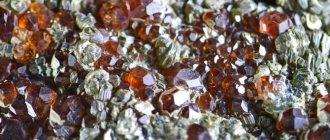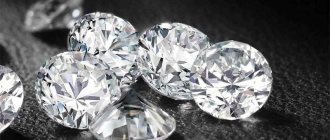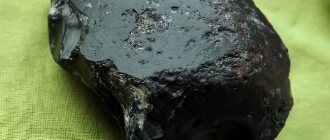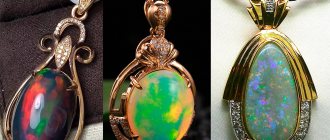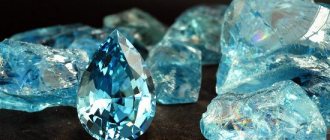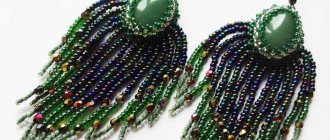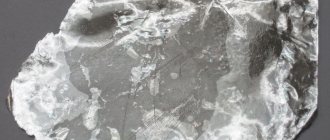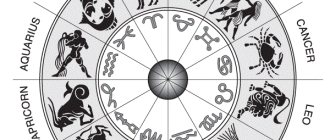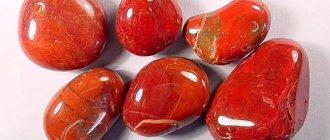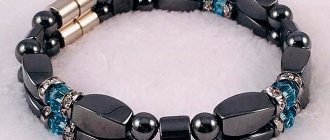Few people know that the citrine stone is one of the types of quartz rocks, and among its closest “relatives” are smoky topaz, all amethysts and even aventurine. However, despite such a large number of related stones, citrine does not lose its bright individuality in comparison with them and always stands out against their background. It is very easy to distinguish from other minerals.
History of citrine
Citrine contains aluminum and iron, due to which it has an unusual lemon color.
Actually, its name in translation means “lemon-yellow stone.” — Advertising —
Residents of Ancient Rome believed that citrine was the very philosopher's stone, as well as a source of peace, charm, self-confidence and eloquence. In Ancient Greece, the mineral was allowed to be used exclusively by orators and noble persons. And in South America, amulets were made from citrines to protect against the bites of poisonous snakes.
In the Middle Ages, people paid attention to the ability of citrine to fight insomnia and nightmares, to give clarity to thinking and sharpness to thoughts. In Russia, citrine was known as a “merchant’s” stone; it was believed that with its help you could get rich. To do this, one had to always wear a gem set in gold as a decoration. Family signet rings were also cut out of citrine to seal letters. But the French called this mineral a talisman of swindlers; thieves and cheaters loved to wear rings with it.
Today, citrines are popular jewelry stones, not only beautiful, but also affordable. They are used to decorate mineralogical collections, and after processing they are inserted into various decorations. Jewelers use transparent, bright crystals, which look especially elegant in gold frames.
Physicochemical characteristics of citrine
Like all other quartz, citrine is composed of silicon dioxide.
Its crystals are usually large in size or form intergrowths. Painted in lemon, yellow or golden brown, transparent color. — Advertising —
Citrine has a trigonal system, glassy luster and a conchoidal fracture; it has no cleavage.
Hardness on the Mohs scale 7. Specific gravity 2.65 g/cm3. Light refraction 1.55-1.56.
Magical properties of citrine
Citrine is a great companion for a person as he loves to interact with people.
He is especially active in relation to those who are involved in solving social problems and issues. Citrines help in establishing important contacts, in financial matters, and rational distribution of resources. It is believed that business people, in order to receive assistance from the gem in doing business, should wear a ring with citrine on their little finger. If you put it on the middle and index fingers, then the oratory skill of its owner will develop. Speakers are recommended to wear a citrine pendant to their speeches in order to attract the attention of listeners, convince the audience that they are right and achieve success and desired goals.
Compatibility with other stones
Citrine belongs to the element of Air. It combines with :
- amazonite;
- amethyst;
- tourmaline;
- topaz.
Mystics advise combining the rock with beryl, chrysoprase, and fluorite. Can be combined with quartz (avoiding morion), demantoid, uvarovite.
Of the fire minerals that are combined with citrine:
- amber;
- cornelian;
- spinel.
Avoid combinations of yellow gem and:
- emerald;
- disgrace;
- pearls;
- sapphire.
Citrine – the mineral of Air
Medicinal properties of citrine
— Advertising —
The healing properties of citrine have been used since ancient times. The mineral was widely used and appreciated by the inhabitants of India: in the treatment of diseases of the gastrointestinal tract and genitourinary system. The stone was also used for poor vision, for the treatment of the spleen and liver, and the musculoskeletal system. Citrine was considered a strong energetically cleansing and restorative stone that normalizes the functioning of the chakras and the conduction of spiritual energy through energy centers. Used as a stone for meditation.
Modern lithotherapy recommends citrine to improve brain function, to eliminate stuttering, and during menopause. It is believed that if you constantly wear jewelry with this gem, then all processes in the body are normalized, vitality begins to fill it, and the processes of cleansing and rejuvenation are activated.
Citrine normalizes hormonal levels, helps remove toxins from the body, cleanses and restores the skin, and alleviates allergic reactions. Physical and mental energy comes into balance under its influence. The warm solar energy of this stone helps its owner in the fight against complexes, gaining confidence in himself and his strengths, and teaches him to live in a state of harmony with the world around him.
Legends
One historical legend has survived to this day. Catherine II liked unusual gems. One day she sent a man to the Ural factory to bring golden-colored topazes. However, only smoky quartz was mined in those possessions. A local deacon came to the aid of the messenger. This man offered to exchange the smoky stone for golden citrine.
The next morning the deacon kept his promise. Catherine was sent the required stone, which she was pleased with. The queen asked to bring more gems, and the same deacon took over. He soon became rich, but it did not last long. One day, this man’s wife went with a loaf of bread to the pharmacist, to whom she complained that she had lost an earring. This is where the secret was discovered.
Having broken the bread, the pharmacist noticed the same earring, but only with a brightly colored yellow gem. And the deacon’s wife had jewelry with a smoky variety of quartz. The color just changed during baking. Thus, the deacon’s secret was revealed, which brought him wealth.
Citrine colors
Natural citrine is usually pale yellow in color.
The brightness and intensity of the color depends on the amount of iron in the sample. In addition, natural stones are often subjected to heat treatment and in this way specimens of lemon, orange, wine, honey, golden, amber and yellow-brown colors are obtained. Also, in the case of annealing smoky quartz, bright yellow citrines are obtained, and after processing amethyst, orange-brown samples are obtained. Citrines that have a vibrant sunny orange color are known as Madeira, as their color closely resembles this wine.
Application area
The breed is used in the jewelry industry. Since the 19th century, citrine personal seals have been made for documentation and letters. Nowadays, all kinds of jewelry are produced. Artificial specimens are mainly used. Natural samples are rare and expensive. Only transparent, brightly colored, perfect stones are suitable for the jewelry industry. More often they are a product of heat treatment of amethyst and morion. He is not afraid of light or temperature. Yellow, greenish varieties of natural stone are valued low due to instability. They burn out completely when heated to 200 degrees.
Jewelry with mineral
Wrist, neck and ear jewelry, rings and rings are popular. The most expensive samples are cut for brooches, pendants, and rings . Low quality material goes into necklaces. Previously, signet rings were made from citrine.
Jewelry with citrine is cheaper than many precious gems, but is loved by the public for its unusual light shimmers. A properly processed specimen displays different shades of yellow. The cut is determined by the degree of transparency of the material. Transparent ones are decorated with diamonds or in a combined form; cabochons are made from flywheels. Opaque varieties are cut flat.
Jewelry with honey quartz goes well with everyday and festive outfits
How to distinguish real citrine from a fake
Citrine crystals of high jewelry quality are rare in natural deposits. For this reason, such a popular and beautiful stone is imitated: ordinary smoky quartz is heated to temperatures of about 500˚C or irradiated with “hard” waves of the electromagnetic spectrum, as a result of which the stones acquire a bright yellow saturated color, reminiscent of natural citrine. High-quality natural citrine is always transparent and not very brightly colored. But only a specialist in laboratory conditions can distinguish such a fake.
Varieties
How such a division into subspecies is not established. Copies are divided according to color scheme. Varieties are determined by the saturation and brightness of color. Examples:
- bohemian (light yellowish);
- Spanish (dark yellow);
- golden (honey yellow).
Special mention should be made of ametrines. This is a combination of citrine and amethyst. The stones alternate pale yellow stripes with lilac-violet layers. Unusual-looking gems are mined in Brazil.
Light greenish minerals are also found in natural conditions. The specimens are called false emeralds. Loss of color under sunlight reduces the value of this variety to zero.
Citrine and the zodiac sign
Citrine is the patron saint of Gemini, Leo, Libra and Aquarius; for representatives of these signs, the mineral will be an excellent assistant in all endeavors. Citrine is not recommended for Taurus, whom it can provoke to various temptations and confuse. Sometimes Capricorn and Sagittarius may not feel the positive effects of the amulet, but the stone will not harm them.
Interesting facts about citrine:
- One of the largest citrines in the world is in the Smithsonian Institution in the USA and weighs 2258 carats.
- In the 19th and 20th centuries, citrine was set in gold to make personal seals to seal letters and important documents.
- Sometimes natural citrines have a greenish tint and are mistaken for emeralds.
- Golden-yellow citrine is often called “golden topaz,” while brownish-yellow is known as “Spanish topaz.” This is due to the fact that cut citrine samples actually resemble topazes in appearance. The latter differ from citrines by higher hardness, pronounced pleochroism, high specific gravity and cleavage.
- Crystals of amethyst-citrine quartz, in which zones of citrine and amethyst colors alternate, are called ametrines (see photo).
Gem Features
Citrine belongs to the quartz group, so the features have something in common with these stones. For example, the properties of a gem somewhat coincide with the special qualities of an amethyst. The first sign of a mineral is color. The color ranges from pure yellow to ocher or greenish tints.
Citrine stone - description:
- the color of the line left is white;
- specific glass shine;
- hardness index - above average;
- fading under the rays of light;
- transparency, sometimes slight turbidity.
Minerals of a light yellow tone are often found. However, when heated to a certain temperature value, the color is saturated, becoming bright and deep. This property has a negative side. Thermal influence deprives the crystal of the ability to change color and the intensity of the shade of grains in transmitted light. Pleochroism disappears.
